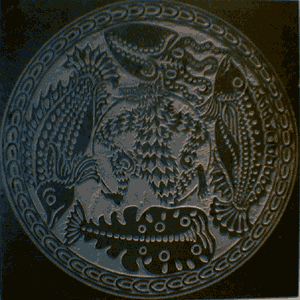|
William P. Reimann |
||||||||||||||||||||||||||||||||||||||||||||||||||||||||||
| ||||||||||||||||||||||||||||||||||||||||||||||||||||||||||

Dancing Wolf & Seafish. Italy, 1st century B.C.
Brazilian River Slate, Limited Edition, 24 x 24 in. |
William P. Reimann
"This motif was found on a painted ceramic plate of Etruscan origin. The fish represented were common to the diet of early Italian fisherman and continue to be popular on Italian menus today. The werewolf at the center of the plate is puzzling for many reasons. The original wolf was depicted as hermaphroditic bearing both male and female characteristics. Undoubtedly it had its origins in early Etruscan myths or folk tales. It is a fiercesome image, and, unlike the benign She-wolf who suckled Romulous and Remus, not at all domesticated. It may have been painted at the plate's center to frighten away evil spirits. " |
|||||||||||||||||||||||||||||||||||||||||||||||||||||||||